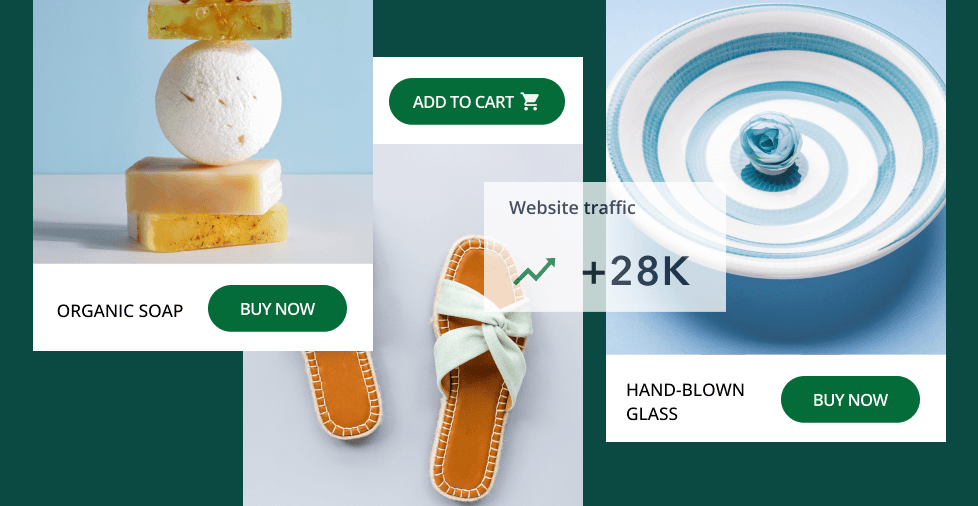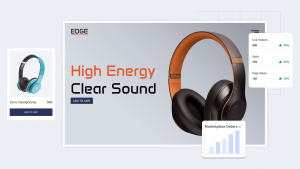Key takeaways:
- Improving your conversion rate can generate more sales from the same amount of traffic, which boosts revenue without spending too much on advertising.
- Adding security features like SSL certificates and two-factor authentication builds trust and makes customers feel safer, increasing the likelihood of completing a purchase.
- Mobile users tend to have lower conversion rates, so optimizing your site for mobile is essential to capture more sales.
What makes an online store successful is its capability to turn visitors into paying customers. The result is measured by your conversion rate, which is the percentage of visitors who complete a purchase.
A stronger conversion rate means more sales from the same number of visitors. That’s revenue without extra marketing spend or added stress.
Let’s check the latest 2025 benchmarks, pinpoint the key factors influencing conversion, and share proven strategies to help you drive stronger results.
What is an eCommerce conversion rate?
An eCommerce conversion rate shows the percentage of people who completed a desired action on your website. That could be buying a product, signing up for a newsletter, or adding something to their cart.
Tracking and calculating this rate let you see what’s working, spot opportunities to improve, and turn more visitors into paying customers without driving extra traffic on your website.
To calculate this metric, you use this formula:

For example, if your store gets 1,000 visitors in a month and 50 make a purchase, your conversion rate would be:

This means that 5% of your visitors are converting into paying customers.
Lead vs. conversion rates
Leads refer to visitors who show interest in your products by signing up for a newsletter, downloading a guide, or creating an account on your site.
While these leads haven’t made a purchase yet, they’re valuable because this means that potential customers are engaging with your brand.
The customer conversion rate focuses on the visitors who complete a purchase. This metric impacts revenue and measures how effectively you turn that interest into actual sales.
Knowing the difference between these metrics helps you understand where to focus your efforts for your online store.
eCommerce conversion rate benchmarks in 2025
Here’s a look at the latest 2025 eCommerce conversion rate benchmarks to help you understand what’s popular in today’s market:
Global conversion rates
As of 2025, the global average eCommerce conversion rate falls between 2% and 4%. This range can fluctuate depending on several factors, such as the type of product you’re selling, how well your website is optimized, and where your business operates.
Industry-specific conversion rates
Conversion rates differ across industries because each market has unique buying behaviors and price points. Here’s a breakdown of the eCommerce conversion rate by industry:
| Industry | Conversion rates |
|---|---|
| Personal care products | 6.8% |
| Food and beverages | 4.9% |
| Electronics & home appliances | 3.6% |
| Fashion, jewelry, shoes | 1.9% |
| Home decor | 1.4% |
| Pet care | 2.32% |
| Arts and crafts | 3.79% |
| Baby and child | 2.3% |
| Cars and motorcycling | 2.1% |
| Electrical and commercial equipment | 2.23% |
| Fashion, clothing, and accessories | 2.44% |
| Food and drink | 2.37% |
| Health and wellbeing | 3.62% |
| Home accessories and giftware | 2.16% |
Industries that offer low-cost, everyday essentials, such as personal care products and food and beverages, see higher conversion rates since customers make quick, frequent purchases.
While industries with expensive or complex products such as home decor and electronics have lower conversion rates. Shoppers in these categories often take more time to research, compare options, and consider their budget before committing to a purchase.
eCommerce conversion rates by device type
One significant factor impacting conversion rates is the device your visitors use. Below are the conversion rates for desktop and mobile device users.
Desktop users still have a higher conversion rate. This is often due to mobile sites not being optimized or users finding it more challenging to complete purchases on smaller screens.
Tablets fall between smartphones and tablets. They offer a bigger screen than smartphones, which makes browsing and shopping easier. However, if your site isn’t optimized for tablets, you could still be missing out on potential sales, just like with mobile users.
Regional conversion rates
Conversion rates also vary based on location. Here are the percentages by region.
Factors like internet access, economic conditions, and consumer trust in online shopping influence these variations. For example, North America has the highest conversion rates, while Asia tends to have lower rates despite its large population of online shoppers.
Conversion rates by traffic source
Where your visitors are coming from plays a big role in how likely they are to convert. Here’s a breakdown of conversion rates by traffic source:
| Traffic source | Conversion rate |
|---|---|
| Organic search | 3.1% |
| Paid search (PPC) | 2.7% |
| Social media | 2.4% |
| Email marketing | 3% |

Factors that impact eCommerce conversion rates
Conversion rates are influenced by various factors that shape the user experience and the overall effectiveness of your site. Here are the factors you need to pay attention to:
- User experience (UX)
- Website design
- Mobile optimization
- Trust and Social Proof
- Page load speed
- Call-to-action (CTA)
- Relevant traffic
User experience
If your site is easy to navigate, with clear calls-to-action and a smooth path to checkout, visitors are more likely to stay and make a purchase.
If customers can’t easily find what they’re looking for, they’ll leave frustrated. So, make sure your navigation is simple, your layout is clean, and your checkout process is streamlined.
If you want an easier way to create a user-friendly website, our website builder can help you set up and optimize your site without the hassle of complex coding.
Website design
A cluttered, outdated, or difficult-to-navigate site can push potential customers away. While a design that makes it easy for visitors to find products and make a purchase can improve your conversion rate.
Keep your design minimalistic, with clear product images, and straightforward navigation. If you want to improve your site’s layout, avoid common design mistakes so you can help enhance user experience and boost conversions.

Mobile optimization
More people are shopping on their phones. In fact, the mobile eCommerce market size in the U.S. amounts to $776 billion. If your site isn’t optimized for mobile, you’re losing big potential sales.
A mobile-optimized site means faster load times, easy navigation, and a seamless checkout experience for your visitors.
Don’t just make your site mobile-friendly but also ensure the checkout process is optimized for mobile too. The easier you make it for users to complete their purchase on mobile, the higher your conversion rates will be.
Customer reviews and testimonials
If your visitors don’t trust you, they won’t buy from you. When customers see that others have had a positive experience with your product or service, they’re more likely to take action.
Show off your happy customers, display reviews prominently, and highlight user-generated content. This builds trust and reassures potential buyers that they’re making the right choice.
Security features like SSL certificates, trusted payment options, and clear privacy policies can make your site feel more secure and reliable, increasing the likelihood that visitors will complete a purchase.
Page load speed
Even a delay of just 1 second can lead to a 7% drop in conversions. To avoid this, optimize images, minimize unnecessary scripts, and choose faster hosting. The more optimized your site, the happier your visitors are and likely to complete a purchase.
You can leverage tools like Google PageSpeed Insights or GTmetrix to analyze and improve your page load times. Aim for load times under 3 seconds to keep your visitors engaged.
Call-to-action
Whether it’s adding an item to their cart or completing a purchase, a strong CTA should be clear, visible, and compelling. Use phrases like “Buy now”, “Shop today”, or “Limited time offer” to create urgency and prompt users to take immediate action.
To create an impactful CTA, it’s important to focus on wording, placement, and design. Follow best practices so you can make your CTAs more effective, and drive better results for your business.
Relevant traffic
Attracting the right visitors is just as important as converting them. If your traffic isn’t relevant, your conversion rates will suffer.
Target the right audience by using the right channels. Whether it’s organic search, paid ads, or social media, you need to drive visitors who are genuinely interested in your product or service.
8 effective tips to improve eCommerce conversion rates
Turning visitors into paying customers requires more than just attracting traffic. Here are tips you can use to improve your conversion rates and deliver results:
- Optimize the checkout process
- Strengthen your credibility and security
- Enhance product pages
- Personalize and recommend products
- Recover abandoned carts
- Implement A/B testing
- Utilize social media for more engagement
- Offer 24/7 customer support
1. Optimize the checkout process
A slow or complicated checkout process is one of the main reasons customers abandon their carts. In fact, 70% of shopping carts are abandoned. This happens because of unexpected fees, requiring customers to create an account, or the checkout process takes too long.
Keep your checkout process simple and fast and let customers check out as guests without forcing them to sign up. Show any extra costs, like shipping, right from the start. The easier and faster it is for people to buy, the more likely they are to finish their purchase.
2. Strengthen your credibility and security
When customers feel confident that their personal and payment information is safe, they’re more likely to make a purchase. Otherwise, they will hesitate, abandon their carts, or even leave your site entirely.
Consider integrating the following security features to your online store to provide a smooth transaction for your visitors:
- SSL certificates. SSL certificates protect your visitors’ data by encrypting it. This means sensitive data (e.g., passwords and credit card numbers) stays safe when they interact with your site.
- DDoS protection. Distributed Denial of Service (DDoS) are attacks that try to crash your website with fake traffic. DDoS protection prevents these attacks from bringing your site down.
- Malware scanning. Regularly checking for malware helps catch harmful software that could damage your site or steal sensitive data.
- Automatic backups. Automatic backups make sure your website data is safely stored, so if something goes wrong (e.g., hacking or server failure) you can quickly restore it.
- Firewall protection. A firewall serves as a security barrier, which blocks bad traffic before it reaches your website and protects your server from potential attacks.
- Two-factor authentication (2FA). Two-factor authentication adds another layer of security by asking for a second form of verification (like a text or app notification) in addition to your password when logging in.
- Daily security monitoring. Constant monitoring of your site helps catch any vulnerabilities or unusual activity before they turn into bigger problems, which in turn gives you peace of mind.
3. Enhance product pages
Your product pages need to be clear, informative, and visually appealing. High-quality images, detailed descriptions, and customer reviews help users make better purchasing decisions.
Product pages optimized for both mobile and desktop provide a smoother experience and are more likely to convert visitors into paying customers.
4. Personalize and recommend products
Showing customers products that match their interests makes them more likely to buy. AI-driven recommendations use browsing history, past purchases, and popular items to suggest relevant products.
According to a recent survey, 91% of consumers prefer shopping with brands that provide offers and recommendations that are relevant to them. A personalized shopping experience keeps customers engaged and encourages them to complete their purchases.
5. Recover abandoned carts
Many shoppers add items to their carts but never complete the purchase. Recover those lost sales by sending automated abandoned cart emails to remind customers of what they left behind. You can also offer a small discount to persuade them to check out.
Retargeting ads on social media or search engines can also re-engage visitors who browsed your site but didn’t convert, bringing them back to finish their purchase.
6. Implement A/B testing
If you’re unsure what works best for your site, A/B testing will help you compare two versions of a page to see which one drives more conversions.
This method lets you test key elements like headlines, product descriptions, images, button colors, and even page layouts to determine what resonates most with your audience.
Testing different versions with separate groups of visitors helps you see what drives more sales. It shows what works and what doesn’t, so you can make changes that improve the shopping experience and boost conversions.
7. Utilize social media for more engagement
Engage with your customers on social media platforms like Instagram, TikTok, and Facebook by responding to comments, sharing user-generated content, and showcasing real experiences with your products.
By making them feel involved and part of your brand story through shoutouts, reposts, and replies, you create a sense of connection. When people see others enjoying your products, it builds trust and makes them more likely to buy.
8. Offer a 24/7 customer support
You never know what your customer needs unless you’re there when they need help. Offer round-the-clock support to show you’re reliable and available.
Whether it’s a quick question before checkout or help solving an issue after a purchase, being responsive builds trust and can be the push someone needs to complete their order.
Robust tools that improve conversion rates
Improving your conversion rate starts with understanding how people use your site. eCommerce tools help you track what visitors do, where they click, and where they leave. Here are some tools that can help you with this process:
- Google Analytics
- Hotjar
- Lucky Orange
- BigCommerce Analytics
Google Analytics
Google Analytics shows you how people find your site, what pages they visit, how long they stay, and whether they make a purchase.
You can track key performance metrics like bounce rate, session duration, and conversion goals. It’s ideal for looking for trends and figuring out which parts of your site need attention.
Hotjar
Hotjar gives you a visual look at how users behave on your site. Heatmaps show where they’re clicking and scrolling, while session recordings let you watch real user journeys.
You can also set up surveys and feedback forms to hear directly from visitors. It’s great for identifying pain points and improving user experience.
Lucky Orange
Lucky Orange offers real-time visitor tracking, session replays, and interactive heatmaps to help you see what users are doing and where they get stuck.
It also includes live chat and surveys so you can connect with shoppers directly and gather feedback on the spot. The insights you get make it easier to fix issues and keep people moving through the buying process.
BigCommerce analytics
BigCommerce has built-in analytics that show you more than just traffic numbers. You can track abandoned carts, in-store search terms, and what products are being browsed or skipped.
This helps you adjust product listings, improve search results, and recover lost sales by understanding what your customers are looking for.
5 common conversion rate mistakes
Even if you have a great product, overlooked details on your website can cause customers to leave without buying. Here are common mistakes that hurt conversion rates and how you can avoid them:
- Ignoring mobile traffic optimization
- Creating a complicated checkout process
- Not tracking or using conversion data
- Not using social proof to build trust
- Not converting your traffic
Mistake 1. Ignoring mobile traffic optimization
Most shoppers use their phones to browse and buy, but a lot of sites still don’t offer a smooth mobile experience. If your site loads slowly, hard to tap buttons, or forces users to zoom in to read product info, it’s going to frustrate people. They’ll likely leave before they even make it to checkout.
Ensure your website is fully responsive, loads quickly on mobile networks, and is easy to navigate on a small screen.
Mistake 2. Creating a complicated checkout process
A tedious checkout process is one of the biggest reasons shoppers abandon their carts. If customers are forced to create an account, fill out too many forms, or deal with unclear steps, they’ll likely give up before completing the purchase.
Keep your checkout as simple as possible. Allow guest checkout, auto-fill known information when possible, and show all extra fees upfront. The fewer the steps, the more likely people are to follow through.
Mistake 3. Not tracking or using conversion data
If you’re not tracking how visitors behave on your site, it’s almost impossible to know what’s working and what’s not.
Tools like Google Analytics, Hotjar, or Lucky Orange help you see where people drop off, which pages they stay on, and what actions they take.
Mistake 4. Not using social proof to build trust
Most shoppers want to know they can trust your business before they buy. If your site doesn’t show customer reviews, testimonials, or trust badges, visitors may hesitate or look for another site.
Make sure reviews are easy to find, display testimonials from happy customers, and include visual proofs like secure payment badges to help new visitors feel more confident about buying from you.
Mistake 5. Not converting your traffic
Bringing more visitors to your site is important, but it won’t lead to more sales unless your site is set up to convert that traffic. Some businesses spend all their time and budget on ads, social media, and SEO, but don’t take the time to improve the experience once someone lands on the site.
Attract the right audience but also make sure your site is easy to use, loads fast, and guides people toward a purchase.
Optimize your eCommerce site for higher conversion rates
Improving your conversion rate is one effective way to grow your business revenue. Make your website user-friendly, simplify the checkout process, personalize the shopping experience, and use proven strategies to turn more visitors into paying customers.
A fast, reliable website plays a key role in conversion success. With reliable web hosting, you can create a faster and more stable shopping experience that supports better conversion outcomes.
Explore our web hosting plans to see how we can help you build a site that converts.
Frequently asked questions
A good eCommerce conversion rate generally falls between 2.5% and 3.2%. However, this can vary by industry, product type, and traffic source.
Take note that what is considered “good” can differ based on factors like market competition, pricing strategy, and user experience.
For example, sectors like health and wellness tend to see higher conversion rates due to repeat purchases and customer loyalty.
Yes, a 10% conversion rate is considered good, particularly for high-intent visitors. This is often seen in cases where customers have been retargeted or have a strong purchase intent.
A 10% rate typically places your store in the top-performing eCommerce sites, as most stores don’t consistently achieve such high figures.
Cart abandonment often occurs due to several common issues that stop customers from completing their purchase. Here are the main reasons:
Unexpected costs
Complicated checkout process
Forced account creation
Lack of trust
Long shipping times
Website performance issues
Limited payment options




